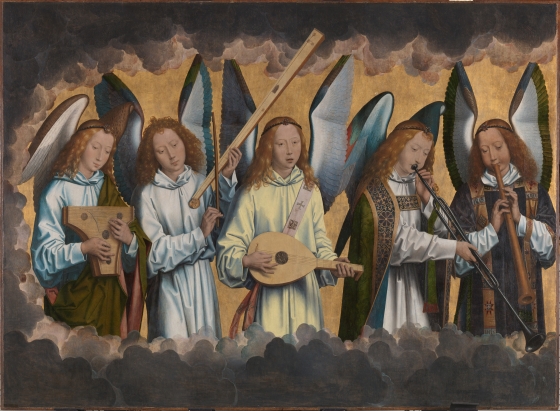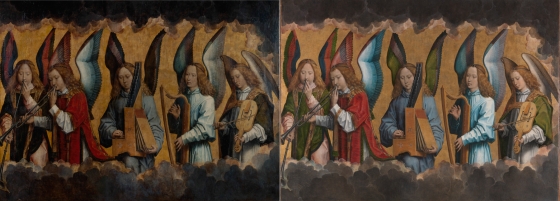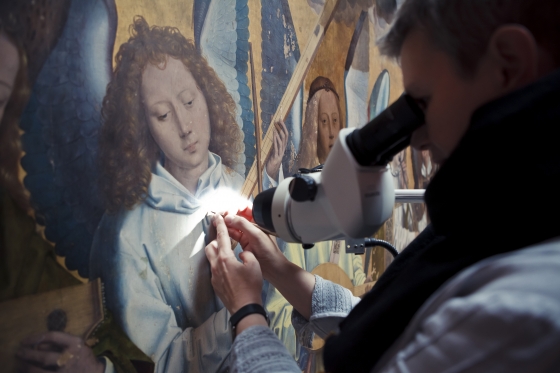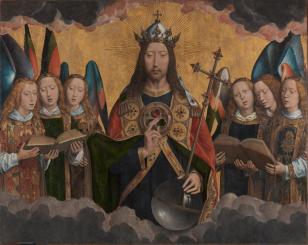This archived website 'Flemish primitives' is temporarily not being updated. Certain functionality (e.g. specific searches in the collection) may no longer be available. News updates about the Flemish primitives will appear on vlaamsekunstcollectie.be. Questions about this website? Please contact us at info@vlaamsekunstcollectie.be.
Restoration of ‘Christ with singing and music-making Angels’

The restoration of Hans Memling's Christ with singing and music-making Angels from the collection of the Royal Museum of Fine Arts in Antwerp (KMSKA) was recently completed. After sixteen years of patient conserving, restoring and researching, the three monumental panels are ready to dazzle at the reopening of the KMSKA in 2019.
Brief History
Between 1465 and 1494, the year in which he dies, Hans Memling (ca 1435-1494) had a studio in Bruges. Starting in 1479, the year in which he completed the Saint John Altarpiece, among other works, the painter experienced his best years. In 1480, he took on Hannekin Verhanneman as a student and a few years later Passchier van der Meersch also came along. These are the only assistants that are known by name. Around 1480, Memling bought the larger of the two houses that he already occupied in Bruges. Artistically and financially, things are going quite well for him. He is a heavily solicited artist and belongs to the top 10 per cent of the wealthiest citizens of Bruges.
Recent archival research by the Centre for the study of the Flemish Primitives of the Royal Institute for Cultural Heritage (KIK) has produced new information about the commission (ca 1480-1490) for the monumental altarpiece for the cloister church of the Benedictine abbey of Santa María La Real in Nájera, in the north of Spain. The only things that have in fact survived are the three panels with Christ with singing music-making Angels from the collection of the KMSKA. They probably constituted the upper register of the large multi-panel work, or Retablo Mayor as it was called on site, which was dedicated to the Assumption of Mary. The life-sized Assumption below was flanked by saints, apostles and martyrs. Below was possibly also a predella with two reliquary coffers present. The Antwerp panels measure together 6,75 metres wide, which is even considerably wider than the Ghent Altarpiece (1432) by the Van Eyck brothers. The three panels were purchased in 1895 by the KMSKA. In 2009, the Antwerp panels were placed on the list of the Masterpieces Decree (Topstukkenlijst).
Iconography

Ash-grey storm clouds open up for a running frieze with a concert of sixteen angels. Against a gilded background, a blessing and crowned Christ as Salvator Mundi stands central with a glass globe with a cross that is reflected in the globe. It is the figurative image for the world that is delivered by the cross. Agyos o Theos, or holy God, appears on the collar of his elaborately decorated alb. To the left and right of Christ are each three angels singing from a hymnal. Different from the singing angels in the Ghent Altarpiece is their unperturbed look. Whereas the singers by the Van Eycks do their best to maintain a certain pitch, those of Memling's singers are most serene. Given that it deals with rather small hymnals, most likely they are engaging in Gregorian music rather than polyphonic.
On the two side panels angels in liturgical garments accompany the vocals with a variety of instruments: stringed instruments such as the lute, the elongated tromba marina, the psalterium, the harp and the violin; wind instruments such a various sorts of trumpets and the shawm; and a portable organ. However realistically the instruments appear, which are executed in detail and that in general are manipulated in a believable manner, specialists still see some imperfections.
Execution

In the ground layer, the preparatory layer that is applied to the panel, chalk and gypsum were both found, while Memling generally used a foundation with the basis of chalk. Because gypsum is a material that was not used in the North, but was indeed used in the South raises the question whether the painting could have been made in Spain. The evidence material is likewise not conclusive. The multi-panel can just as well originated in the Bruges studio.
From the underdrawing, it appears that the composition is expanded in preparation in Memling's quick, free manner of working. The sketch-like manner of the underdrawing is typical for the later Memling. During the research period, letter combinations in the underdrawing were recovered. They probably indicate the desired colour.
Some parts, in the right panel among others, are painted by a somewhat less skilled hand. The precise division of labour remains open for discussion. With the art production from the Burgundian Netherlands, one must keep the sharing of the studio in mind. An altarpiece is the fruition of collective work within a delineated stylistic spectrum. A Memling must always be recognisable as a Memling, but can always deviate in subtle ways. Memling was a master in the rationalising of his work, by which he worked according to a calibrated schema and was frugal with his time. The build-up of the paint primarily consists of two and sometimes three layers. Scant pentimenti, or corrections that were brought in during the painting process, were found. The pigments that were used are standard for the fifteenth century.
Research, Conservation and Restoration

The restoration began in 2001, but is not, however, maintained without interruption until 2017. During the sixteen years, there is much that changed. The original restoration team, led by Lizet Klaassen dwindles, the KMSKA closes and all works are relocated to an external repository. In the meanwhile, the restorers also work on other restoration projects. That the restoration lasted so long primarily has to do with the enormous surface area of the panels and the complexity of the treatment.
Because of the non-restored condition of the yellowed varnish and the darkened retouches, the panels are never estimated at true value. After sixteen years of restoring, that problem is remedied and it becomes noted that the painting, certainly for such a large work, is very carefully executed.
During the campaign an extensive preliminary investigation is begun. The paintings were studied and documented in normal light, but also with x-ray, infrared and ultraviolet radiation. X-rays and infrared radiation penetrate through the layers of paint and yield information that cannot be obtained by the naked eye. Scientific research was carried out by the Universities of Antwerp and of Hamburg, the European mobile laboratory MOLAB and INOA (Istituto Nazionale de Ottica Applicata-CNR), the National Gallery in London and the Centre for the study of the Flemish Primitives in the Royal Institute for Cultural Heritage. At the same time, the restoration team was assisted by an international advisory committee.
After the preliminary investigation, attention was given to the fixation of the paint layers to prevent them from flaking. The parquetting, or reinforcement by means of wooden slats on the backside, was treated by a specialist. A painting panel reacts to atmospheric conditions, either it contracts or expands. Parquetting, an obsolete technique, can inhibit that and can have dire consequences for the paint layer. Old, coloured varnish and old retouches were removed with solvents. A salt crust of calcium oxalate made parts of the composition illegible. Solvents were inadequate with removing the crust, which had to be mechanically (with scalpel and microscope) removed. The lacunae, or damages to the paint layer, which came to light afterwards, were filled in and retouched. After this, a thin layer of varnish was applied. A final layer of varnish followed in February 2017.
(March 20, 2017)







